It's a rum do
It's a rum do. The end of March - only a few days from Easter - and Snowdrops are still in full bloom in the garden. Below average daytime temperatures since mid-January and a biting wind from the north or east throughout February and March has left us all feeling cold, cold, COLD! It has not done a lot for the wildlife either. At Blue House, the breeding Lapwings should be on eggs by now but there is hardly even a flicker of display as yet. Crows feed unmolested on the flooded area, whereas when there are clutches to defend they would be subject to continuous aerial assaults. If the cold wind drains heat from our bodies it does the same to them; they need to feed more than in a milder spring in order to maintain a condition fit for breeding. But the wind has a knock on affect. It retards plant growth - the hedgerow blackthorns are but a shadow of emerging bloom at present whereas, some years, their flowering is all but over by the close of March - and the lack of blossom, allied to the cold temperatures, inhibits the emergence of nectar and pollen seeking insects. The ground too is cold and wet - the water table, still high from last year's rains, tops up again after every heavy shower. Invertebrates are slow to emerge from winter. Less invertebrates means less food for the Lapwings at this critical time of year, which means they have less body fat to provide the energy needed for the onset of nesting and the cold, sodden ground, with no hint of warmth from the air, threatens the survival of the developing embryos. It is well that they have delayed laying but the longer this weather continues the less time they will have to rear a brood. In a normal year should the first, or even the second clutch fail, they will often try a third time but another week or two of this will limit their choices. As I said, it's a rum do and not only for Lapwings but lots of other wildlife as well. The ducks and geese have delayed departure to their northern breeding grounds, Brent Geese among them, over 2000 of which still reside on the farm, many feeding outside Nick's kitchen window' like the ones pictured here.
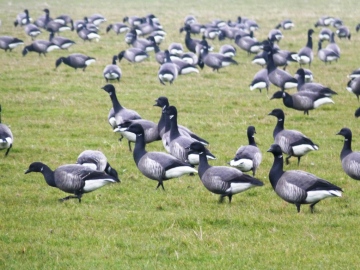
This fine drake Shoveler is more likely to be a resident and will soon be eyeing the females. He was feeding outside the New Hide and appeared to be 'shoveling' up mouthfuls of New Zealand Pygmyweed. If so, he need never go hungry, there are several tonnes of the wretched stuff on The Flood.
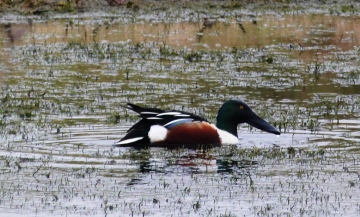
Cold springs are nothing new, of course, and two or three week spells of north or north-easterly winds are not unusual as late as April or May. But by then the days are longer and the sun is higher and high pressure systems more often bring blue skies than cloudy ones, as is not the case in the winter. I am not sure I can recall such a prolonged period of winds from the heart of Russia at this time of year before, though, unless it was in the infamous winter of 1963.
On a more cheerful note, volunteer work parties are one way of keeping warm; either digging up gorse bushes and young birches on heath-land at The Backwarden or layering hedges at Stow Maries Halt EWT Reserve. The one pictured may not be quite the standard achieved by the professionals at Highgrove but I am still pleased with my part in creating it!
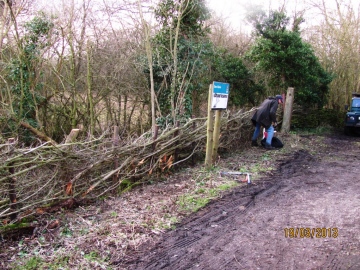
Deceased Frog
Thanks for the comments Graham, you may well be right about the deceased being weakened by the weather conditions, it does not appear to have shown up in the other inhabitants of the pond. I will have a look around web for further info.The rest have now left the pond and dispersed into the garden leaving a huge amount of spawn. Peter. Deceased Frog
Peter, it does sound as though your Frog succumbed to red-leg disease, although it is supposed to be more prevalent in late summer and autumn than in winter. However, around ten years the thriving population of frogs in my garden pond was decimated by what appeared to be this disease and I found no less than 19 of them dead in February/March, soon after they emerged from hibernation. All showed the signs you describe, namely, inflamed looking patches of red or pink, especially on the legs, and split skin. Since then I have had very few frogs in the pond and none this year. As you have only found one it could be that this was an animal weakened by long months of hibernation and thus particularly vulnerable to this type of bacterial infection. There are several good websites that can provide more detailed information - Graham Deceased Frog
The frogs in our pond were extremely active and vociferous Saturday night (16/03/2013). We already had literally heaps of spawn in the pond so overcrowding was likely to be a problem.
Sunday morning, yes more spawn, but near the pond was a dead frog. It had a distinct pinkish colouring particularly on the legs and under belly. The corpse was very bloated and down one side from the abdomen through one of its back legs, it appeared to have split open with the skin peeled back exposing the underlying muscles. It was as if it had burst its skin.
Unfortunately I did not think to photograph it before burying it in the garden, we had a visitor with two dogs and I didn’t want then to find it.
Would this be symptomatic of the disease commonly known as “red leg†?
We have had pink/red frogs in past years, but never previously found one in this condition.
I have read that overcrowding with frogs kept as pets introduces bacteria to the collection causing the frogs immune system to break down resulting in death from "red leg". Could this, I wonder, be the case in our small pond where we have had 5 pairs and loads of spawn. Has this upset the water balance even though it appears clear? Not quite Spring
 0717 This morning drew back the curtains. What can I say, Gale force gusts of northerly wind white-out blizzards. Spring!
There must be a slightly warmer micro-climate in Upminster than here in the wilds of Ingatestone! The Cherry Plum in this area is barely staggering into bloom and the hedgerows still look bleak and colourless. We can muster a few flowering weeds - or misunderstood wild flowers as I prefer to call them - but the only unseasonal blooms have been a few Sticky Groundsel on the railway embankment. I see that Upminster has House Sparrows (Sprogs) and Starlings (Stygs) too. Lucky you! There are around three of the former in my garden at the moment and less than a dozen Starlings. Recent insulation work to the roofs of nearby bungalows has meant that they no longer have access under the eaves and are struggling to find nest sites in the neighbourhood. What we do have here - and which I am gazing on at the moment as the snow flurries outside the window - is up to 60 Goldfinches, 30 Chaffinches and 40 Siskins on the bird feeders. Two other householders within a hundred yard radius of my house also feed them, hence the large numbers - far more than I see in the local countryside nowadays. We also have Egyptian Geese, although not in the garden! They nest at a local fishery and usually manage to rear one or two broods of goslings despite the present of several giant-sized Catfish in the lake they frequent.
Last week's spring teaser was welcome - a sign of the warmth to come - even if we have now retjurned to winter. On the Tuesday I was helping to lay a hedge at Stow Maries Halt EWT Reserve, a most satisfying task, as a certain Prince for whom I have a great deal of respect confirmed on Countryfile last night! It was so warm we were all shedding coats and it was very pleasant sitting in the sunshine while eating lunch. We saw nlo butterflies that day but Comma, Brimstone and Small Tortiseshell were all reported by the Essex Moth Group. Did catch the first gtwo moths of the spring, though, a Chestnut and Common Quaker.
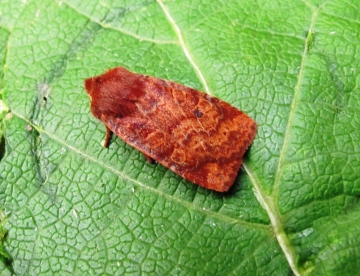
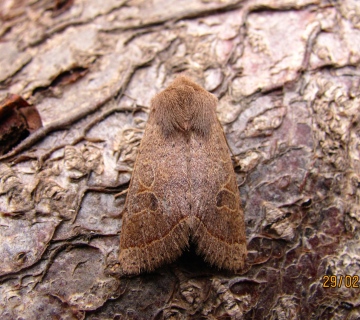
Wednesday was equally pleasant, resting in the sunshine on the seawall at Blue House Farm listening to the first Skylarks ascending and watching the male Lapwings' ecstatic display flight. This one was photographed during last year's miserable summer and had a right to look a bit fed up, as it's young, along with those of most other pairs, died soon after hatching of the cold and wet. Hopefully they will have better luck this summer - as long as the jet stream behaves itself - and we can all look forward to long lazy days in the sunshine!
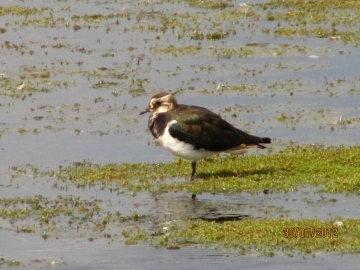
Egyptian Geese mainly
Thank you to Peter Pearson for your info about these geese, and for your lovely picture which is exactly what we saw. I am not sure whether I should be pleased that there are lots of them in East Anglia and Essex, or whether to say 'Boo' as they are yet another alien! Will they take over like the Canada Geese are?
And, with Tuesday seeming to be summer, it would have been even better if we had done our trip then! However, it did not last long and we are back to grey moist weather, and chilly, so we have to wait a bit longer for some good sunshine. Egyptian Goose (Alopochen aegyptiacus)
Mary, if you are not already aware, just thought you may like to know, the Egyptian Goose you observed in London is a regular in Essex. There are, apparently some 300 -400 pairs in East Anglia mainly, but I have seen them in Berkshire, all originate from introduced ornamental stock. Their range is Africa south of the Sahara and the Nile Valley and are akin to the Shelduck. 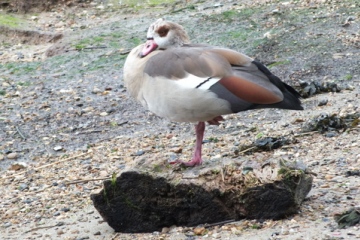
The one pictured here was photographed at Hopping Bridge, The Walls, Mistley on the Stour and they are often found in the meadows between Dedham and Flatford and on Mistley Place Park where I have seen then roosting in the trees. They can also be found at Abberton Reservoir. They have bred in the area, two adults brought two goslings to Hopping Bridge last year, to where visitors feed the ducks, swans and geese.
Mistley Walls also had a pair of Black Swans who turned up with young last year but these seem to have disappeared. Spring is definitely sprung today, 4th March
We went to the British Library in Euston Road this morning. After a quick lunch, we walked along Pentonville Road to the Angel and then joined the towpath of the Regent Canal all the way to Limehouse and then caught the train home.
The towpath was wonderful in the sunshine, and mostly sheltered from the chilly breeze. The temperature reached 8°C! A dizzying heatwave! Plants in flower in the sunshine included: Common Whitlowgrass, Shepherd's-purse, Hairy Bittercress, Common Field-speedwell, White Comfrey, Chickweed, one patch of Primrose with about 10 flowers open, 2 Dandelion, several flowers of Creeping Buttercup (yes, I know it is not allowed to flower yet!), several Alder with catkins all dropping pollen, several Goat Willow showing their silvery catkins just emerging from bud, Cherry Plum in full white blossom, and there were others but this is as many as I can remember. Other plants that were leaping into life but with no flowers today included: White Deadnettle, Red Deadnettle, Alexanders, Cow Parsley, Herb-Robert and more. The leaves of Alexanders and the flowers of the Creeping Buttercups glowed brilliantly in the bright sunshine.
Nearby in bare trees were chattering groups of House Sparrows and a group of Starlings. In addition, there were loads of water birds on the Canal and plenty of folk with stale bread feeding it to the birds. These water birds (Coot, Moorhen, Canada Geese, assorted Gulls, Mallard, a Swan or four) seem to survive entirely on bread, and white bread at that.
We made a short diversion into Victoria Park, where there is a lake full of more water birds fed on white bread, and two geese we did not recognise. On looking in our bird book at home, they were clearly Egyptian Geese, so presumably imported deliberately, as opposed to the other alien geese that had arrived unintentionally.
And to cap it all, the towpath was busy with many people enjoying the sunshine, some running, some on bicycles, many just walking or strolling along, but a constant stream out enjoying the spring air.
After a long and rather cold winter, this was just the tonic we all needed! |
|
Archives:
May 2020
Aug 2019
Jan 2019
Sep 2018
Jul 2016
Oct 2015
Jul 2015
May 2015
Apr 2015
Mar 2015
Feb 2015
Jan 2015
Dec 2014
Oct 2014
Sep 2014
Aug 2014
Jul 2014
May 2014
Apr 2014
Mar 2014
Feb 2014
Jan 2014
Dec 2013
Nov 2013
Sep 2013
Aug 2013
Jul 2013
Jun 2013
May 2013
Apr 2013
Mar 2013
Feb 2013
Jan 2013
Dec 2012
Nov 2012
Oct 2012
Sep 2012
Aug 2012
Jul 2012
Jun 2012
May 2012
Apr 2012
Mar 2012
Feb 2012
Jan 2012
Dec 2011
Nov 2011
Oct 2011
Sep 2011
Aug 2011
Jul 2011
Jun 2011
May 2011
Apr 2011
Mar 2011
Feb 2011
Jan 2011
Dec 2010
Nov 2010
Oct 2010
Sep 2010
Aug 2010
Jul 2010
Jun 2010
May 2010
Apr 2010
Mar 2010
Feb 2010
Nov 2009
Oct 2009
Aug 2009
Jul 2009
Jun 2009
May 2009
Apr 2009
Mar 2009
Feb 2009
Jan 2009
Nov 2008
Oct 2008
Sep 2008
Aug 2008
Jul 2008
Jun 2008
May 2008
Apr 2008
Mar 2008
Feb 2008
Jan 2008
Dec 2007
Nov 2007
current posts
|































